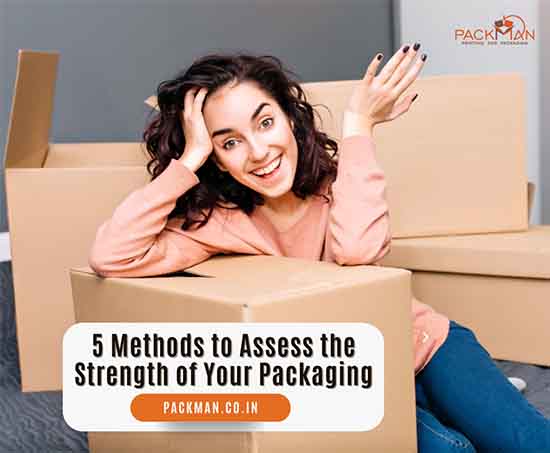When it comes to creating packaging design, aesthetics are essential in making an excellent first impression of your products to your buyers. However, it is not merely about whether you have a pretty design or not. The quality of your packaging – which includes structural integrity, sturdiness, and durability – are all essential factors in the practicality of packaging. Eventually, when you ship your products out to customers, your package will possibly go through the diverse (and harsh) conditions of shipping prior to it reaching your customer.
With that being said, there are several tests you can carry out on your packaging boxes to measure the quality of your packaging. This blog by Packman Packaging Pvt Ltd India’s top corrugated boxes manufacturer shares various types of packaging tests that you or your supplier needs to conduct, along with best practices for each.
Packaging drop test
Drop your packaging at different orientations and heights several times to see how your products and packaging hold up in these circumstances. The international standard is from ISTA (International Safe Transit Association), and the ISTA 1A drop test procedure is the accepted international standard for drop tests.
Carton weight Drop height
1 to 9 kg 76 cm
10 to 20 kg 61 cm
19 to 27 kg 46 cm
28 to 45 kg 30 cm
46 to 68 kg 20 cm
As one can see, lighter cartons are dropped from a higher height compared to heavier cartons. At any height above 76 cm, it becomes unrealistic to conduct a drop test to see if your packaging will secure your product.
Process
Drop your packaging carton at an appropriate height form 10 times from various sides.
Effectively, one needs to be dropping the shipping carton:
- On the most fragile corner (where it is taped shut)
- On the edges that come from the fragile corner (3 drops)
- On the remaining 6 sides
Your carton fails the drop test if any of the following happens:
- There is significant damage to the carton (it’s fully smashed, torn, or is open)
- There is significant damage to the interior packaging box (it’s totally smashed, is entirely torn or broken)
- The product inside the internal packaging box is deformed, scratched, dented, damaged, and unable to be used,
If you see certain dents on the corners or edges of your shipping carton post the drop test, that is normal. The aim of the shipping carton is to safeguard what’s inside, so any deformation to the shipping carton itself is normal as long as the products inside are total, protected completely safe, and unharmed from the drop tests.
Mullen burst test
The Mullen Test checks how much force is needed to burst the corrugated board or paperboard. This is essential because it shows you how much force your box will be able to withstand and how much weight your box is able to hold when your boxes are tossed here and there, which will possibly happen with couriers and their rough handling of packages.
A small portion of your corrugated packaging is inserted flat in between a machine where a small rubber ball inserts pressure under the packaging to check how much force it will withstand before bursting. Burst tests are calculated in pounds per square inch and are reported as a box rating. For instance, a 200# rating means that the box can withstand 200 pounds per square inch force applied prior to bursting.
Corrugated board strength for single wall corrugated
Bursting test Maximum suggested loading limit for each carton
125# 9.07 kg
200# 15.87 kg
Bursting test Maximum suggested loading limit for each carton
200# 36.28 kg
350# 54.43 kg
ECT (edge crush test)
The ECT or Edge Crush Test measures how much force the corners and edges of corrugated material are able to take until it is crushed. This is essential since the corners and edges are majorly responsible for keeping the shipping carton upright and should be strong enough to hold all of the weight (stacks of cartons) on top of it.
A piece of your corrugated material is kept upright between the machine and compressed at various pressures. ECT is measured in pounds per inch and is reported as an ECT rating. An ECT rating of 32 is most frequently used as a baseline for single-wall corrugated boxes and is suitable for many lights to medium-weight products. A corrugated box having an ECT rating of 32 means that it is capable to withstand a stack of up to 29.48 kg.
Vibration test
Vibration tests check how your packages will perform during transport. It simulates the kinds of vibrations that packages might be subject to (on trucks or planes) which could cause cartons to come apart at the seams.
There are 2 common forms of vibration tests:
Random Vibration: This test simulates a truck or plane ride.
Sine Vibration: It identifies which frequencies are more hazardous to your products.
Each packaging consists of a natural frequency, which is its natural vibration. A frequency sweep is done by moving up and down from a low to a high frequency. During this frequency sweep, the package is kept on the vibration table.
When it reaches the natural frequency of the package, the table will become more still. It means the vibration and natural frequency have matched. When that occurs, there are more probabilities of damage due to the resonance. The aim is to have the vibration at a bay from the package’s natural frequency.
Moisture level test
As you know weather impacts the packaging material, and how high humidity levels in the environment make way to internal moisture within the cardboard, and this has a straight impact on the strength of corrugated boxes like mailer boxes or shipping cartons.
Certain parts of the production procedure, including printing and gluing, all have moisture. Coupled with high humidity levels in which the packaging boxes might be produced, it means that more time may require to be allocated to drying the packaging or corrugated boxes.
Due to this, one way of testing your packaging and how much moisture it has is to use a moisture meter. A moisture meter checks the percentage of moisture in the material itself and is an indication of whether the boxes require more time to dry.
As a rule, moisture levels must be no more than 25% (the lower, the better).
For packaging having high moisture levels, it may feel a bit flimsier, but this might not be an indication that your box is in fact weaker. For this, you can conduct Mullen’s test (burst tests) to truly check the strength of your packaging. If you do see that your boxes feel a little flimsy, take them out of your shipping carton and provide them some time to dry out.






